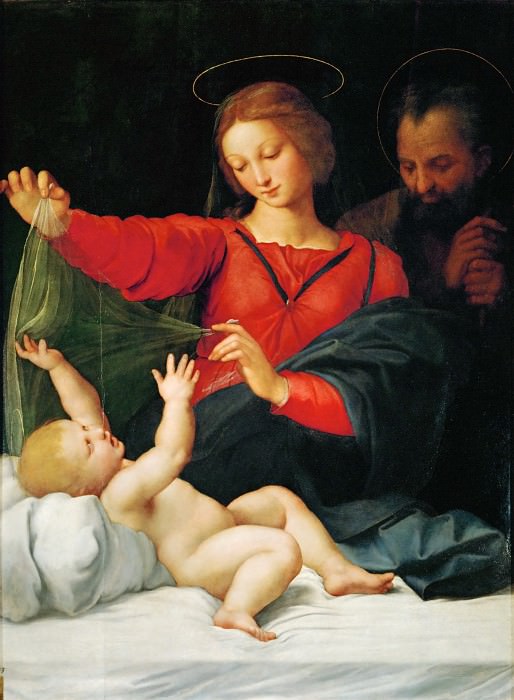Madonna of Loreto Raphael (1483-1520)
Raphael – Madonna of Loreto
Edit attribution
Download full size: 3225×4400 px (3,2 Mb)
Painter: Raphael
Location: Conde Museum (Musée Condé), Chantilly.
Raphael Santi is the creator of masterpieces, many of which have become invaluable assets of world culture and altarpiece painting. The artist created in his own inimitable style, combining the mundane and the divine in immortal inspiring images. On the tomb of the great painter delighted contemporaries inscribed the words that during the artist’s lifetime nature feared to be defeated, and after his death feared to die. From his early years until his apotheosis in the creation of the "Sistine Madonna" in 1513, Raphael depicted the Madonna in different variations, many works of the unsurpassed master to this day illuminate the churches of Italy and the Vatican.
Description of Raphael Santi’s painting, Madonna with Veil
Raphael Santi is the creator of masterpieces, many of which have become invaluable assets of world culture and altarpiece painting. The artist created in his own inimitable style, combining the mundane and the divine in immortal inspiring images. On the tomb of the great painter delighted contemporaries inscribed the words that during the artist’s lifetime nature feared to be defeated, and after his death feared to die.
From his early years until his apotheosis in the creation of the "Sistine Madonna" in 1513, Raphael depicted the Madonna in different variations, many works of the unsurpassed master to this day illuminate the churches of Italy and the Vatican. The history of the depiction of the "Madonna with the Veil" was more dramatic and mysterious.
The painting was commissioned by Pope Julius II for the church of Santa Maria in Via Popolo, where it was located next to a portrait of the pontiff, also made by Raphael. It was Julius II, impressed by the "Madonna with the Veil", who commissioned the artist with a future altarpiece for the monastery of St. Sixtus. For a long time, the "Madonna with the Veil" and called "Madonna del Popolo", until at the end of the XVI century it was sold to the private collection of Borghese. Then her traces were lost several times, for some time the nuns of the monastery in Loreto considered her Madonna del Popolo, why for some time she was called "Madonna of Loreto", but in the middle of the XVIII century, the image finally disappears.
The picture, executed on a specially treated board, depicts the Holy Family. Mary plays serenely with the translucent veil and the awakened Child; they are watched by Joseph whose figure, according to the research of the scholars, was added later instead of the window originally depicted behind Mary. The face of the Madonna leaning over her son is filled with infinite tenderness and quiet sadness; she is calm and enjoys the short period of carefree communion, knowing what fate awaits her miraculous child.
The light in the painting comes only from the snow-white sheet and the shining body of Jesus; Mary’s red dress gives the composition a light joy and sublime mood, but the rest of the image is shrouded in dense darkness. Not a shadow of a smile on the face of the Holy Virgin, Joseph does not hide his sorrow and tensely clutches his hands behind the Virgin’s back. The joy of being and the pain of all human suffering are woven together in the painting into a complex and inexpressible gamut of feelings and emotions.
In the 20s of the last century, the picture is again considered to have been found. The famous art historian and restorer IE Grabar brings from Nizhny Tagil disfigured by time and insects image, which has all the hallmarks of a lost masterpiece by Raphael. After three years of restoration, he still attributed the picture as an original, and until the end of the 70s the picture was exhibited at the Pushkin State Museum, but then the museum staff denied attribution and returned the picture to the Nizhny Tagil Museum.
Кому понравилось
Пожалуйста, подождите
На эту операцию может потребоваться несколько секунд.
Информация появится в новом окне,
если открытие новых окон не запрещено в настройках вашего браузера.
You need to login
Для работы с коллекциями – пожалуйста, войдите в аккаунт (open in new window).




















You cannot comment Why?